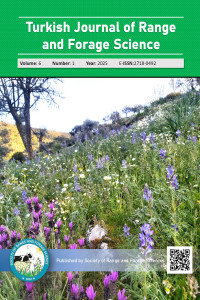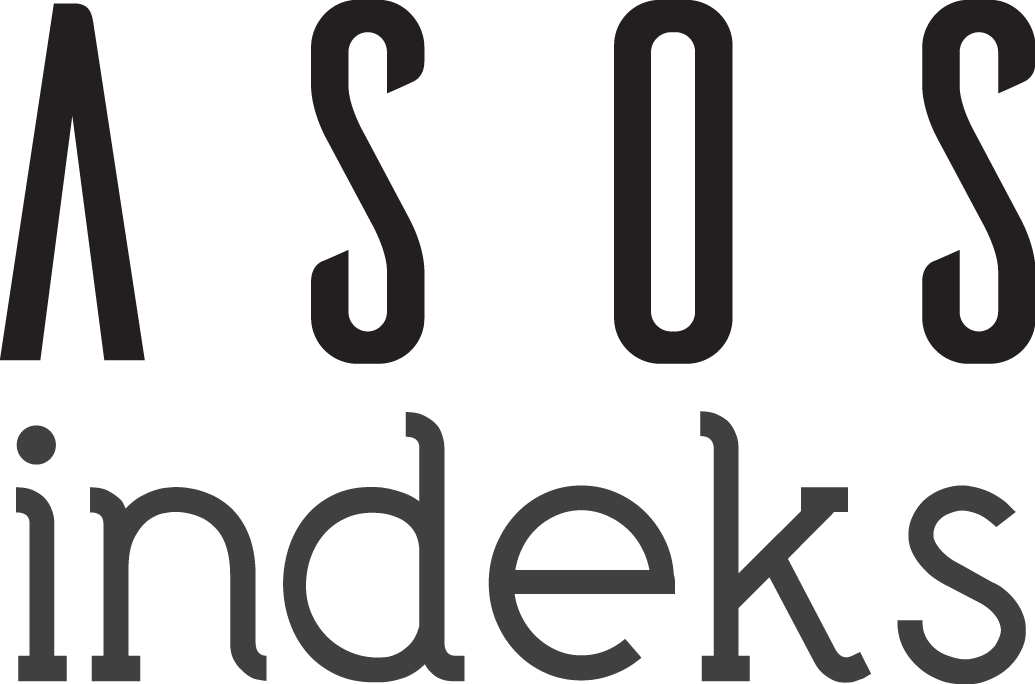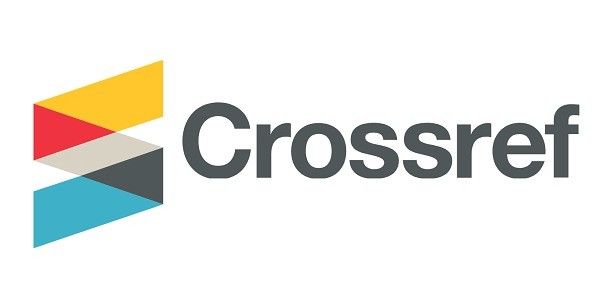Abstract
This study was conducted between 2013 and 2015 in the Çarşamba and Bafra districts of Samsun province to quantify the amount of post-harvest residues (kg/da), including stems, branches, leaves, and unmarketable fruits, most widely grown plants in the region and considered waste. Additionally, the quality and palatability of silages produced from these residues without additives were evaluated.
In the study, tomatoes (T), fresh beans (FB), capia pepper (CP), pointed pepper (PP), white cabbage (WC), and red cabbage (RC) grown in 9 villages in Bafra district and 7 villages in Çarşamba district of Samsun were used. Maize (M) was used as a standard. The research was conducted to according randomized block design with 10 replications.
The highest and lowest dry matter values in vegetable residues were obtained from T with 25.73% and WC with 14.68%, respectively. The highest and lowest amounts of residue taken from the unit area were obtained from WC with 2791.9 kg/da and FB with 988.6 kg/da, respectively.
The highest and lowest values obtained from the silage analyses were as follows: pH (6.22 in T - 4.73 in WC), crude ash (38.95% in WC - 26.16% in FB), organic matter (73.87% in FB - 54.98% in WC), crude protein (15.86% in FB - 13.32% in FB), crude fat (3.17% in FB - 0.7% in CP), ADF (39.98% in PP - 16.96% in RC), and NDF (51.59% in T - 22.64% in RC), respectively.
According to Flieg scores, it has been determined that CP is in the "good" quality class, FB, PP, WC, and RC are in the "moderate" value, and T is in the "low" quality class. According to the Relative Feed Values, it was determined that WC and RC were "highest", PP and FB were "very good", T and CP were "good" and all silages were consumed by animals in palatability tests. In the final scoring, the highest score after M was obtained from CP, followed by PP, FB, WC, RC, and the lowest score was obtained from T silage.
Project Number
TAGEM /TBAD/14/A03/P02/002
References
- Agneessens, L., De Waele, J., & De Neve, S. (2014). Review of alternative management options of vegetable crop residues to reduce nitrate leaching in intensive vegetable rotations. Agronomy, 4(4), 529–555. https://doi.org/10.3390/agronomy4040529
- Akyıldız, R. (1983). Feeds Information and Technology. Ankara University Faculty of Agriculture Publication No: 868, Ankara.
- Alçiçek, A., Kılıç, A., Ayhan V., & Özdoğan, M. (2010). Forage production and problems in Turkey. Turkey Agricultural Engineering VII. Technical Congress, 11(15), 1-10.
- Alçiçek, A., Tarhan, F., Özkan, K., & Adışen F. (1999). A Study on the Determination of Nutrient Content and Silage Quality of Silo Feed Made in Some Dairy Farms in İzmir Province and its Surroundings Animal Production 39-40: 54-63.
- Alçiçek, A., & Özkan, K. (1996). Determination of lactic acid, acetic acid, butyric acid in silo feeds by distillation method. Journal of Ege University Faculty of Agriculture 33(2-3), 191-198.
- Anonymous. (2014). Crop Production Statistics Database, forage crop production and silage corn production data in Samsun. According to ISIC Rev3 Classification.
- AOAC. (1990). Official Methods of Analysis. 15th ed., Association of Official Analytical Chemists. Arlington, VA.
- Ashbell, G., Z. G. Weinberg, A. Azrieli, Y. Hen and B. Horev,.1991. A Simple System to Study the Aerobic Deterioration of Silages. Canadian Agric. Eng. 33,391-393.
- Binversie, L., & Miller, Z. (2013). Feeding Cabbage Waste. University of Wisconsin Extension, Madison, WI, USA.
- Cao, Y., Cai, Y., Takahashi, T., Yoshida, N., Tohno, M., Uegaki, R., Nonaka, K., & Terada, F. (2011). Effect of lactic acid bacteria inoculant and beet pulp addition on fermentation characteristics and in vitro ruminal digestion of vegetable silage. Journal of Dairy Science, 94, 3902-3912.
- Çakmak, B., Yalçın, H., & Bilgen, H. (2013). The Effects of Packing Pressure and Storage Time on Raw Nutrient Content and Quality of Harvested and Fermented Corn Silage, Ege University, Faculty of Agriculture, Department of Agricultural Machinery, İzmir, Turkey Journal of Agricultural Sciences 19, 22-32.
- Çelik, A., & Demirbag, N. (2013). The effect of agricultural supports on forage crops cultivation and production in Turkey. Publication No: 215 ISBN: 978-605-4672-40-0. Ankara
- Çelikel, G. (2005). Selection of Big Nut (Arbutus unedo L.Eracaceae) in the province of Sinop and the town of Yakakent of Samsun. OMU Department of Horticulture, Master's thesis. Samsun.
- Çiğdem, İ., & Uzun, F. (2006). A Research on Some Silage Sorghum and Corn Varieties That Can Be Cultivated As Second Crop In The Soil Areas Of Samsun Province. Omu Zir. fac. Journal, 21(1), 14-19.
- Demirsoy, H. (1999). Studies on the breeding of Can plum types in Çarşamba plain and the determination of the usability of some selected types as clone rootstocks for Peach and Plum. OMÜ Horticulture Department, Ph.D. thesis. Samsun.
- Di Blasi, C., Tanzi, V., & Lanzetta, M. (1997). A Study of the Production of Agricultural Residues in Italy. Biomass and Bioenergy, Vol. 12 No.5 pp. 321–331.
- Erdal, Ş., Pamukçu, M., Ekiz, H., Soysal, M., Savur, O., & Toros, A. (2009). Determination of Silage Yield and Quality Characteristics of Some Silage Corn Variety Candidates Akdeniz University Journal of Faculty of Agriculture, 22 (1), 75–81.
- Filya, I. (2004). Studies on the Use of Organic Acids in Silage Fermentation 1. The effect of a formic acid-based preservative on the fermentation, microbial flora, aerobic stability and in situ degradability properties of corn silages made under laboratory conditions. Journal of Agricultural Sciences, 11 (1), 51-56.
- Gülsün, B., & Miç P. (2018). A Multi-Purpose Programming Approach for Economical Determination of Basic Feed Amounts in Ration Preparation. Niğde Ömer Halisdemir University Journal of Engineering Sciences, 7(2), 634-648.
- Harmanşah, F. (2018). Quality roughage production problems and suggestions in Turkey. Turktob Magazine, 25, 9-13.
- Ishida, H., Suzuno, H., Sugiyama, N., Innami, S., Tadokoro, T., & Meakawa, A. (2000). Nutritive value on chemical components of leaves stalks and stems of sweet potatoes (Ipomoea batata poir.). FoodChem., 68, 359-367.
- İptaş, S. (1993). A research on the feed values of different corn varieties and legumes ensiled as plain and mixed. Gaziosmanpaşa University Faculty of Agriculture Journal, 10(1993), 202-209.
- Jeroch, H., Flachowsky, G., & Weissbach, F. (1993). Futtermittelkunde. Gustav Fischer Verlag, Stuttgart.
- Kafle, G. K., Bhattarai, S., Kim, S. H., & Chen, L. (2014). Anaerobic digestion of Chinese cabbage waste silage with swine manure for biogas production: batch and continuous study. Environmental Technology, 35, 2708-2717.
- Kaplan, M., Kokten, K., & Akcura, M. (2017). Assessment of Genotype × Trait × Environment interactions of silage maize genotypes through GGE Biplot. Chilean Journal of Agricultural Research, 77(3), 212-217.
- Karabulut, A., & Canbolat, Ö. (2005). Feed Evaluation and Analysis Methods. U.U. Publications, Pub. No: 2.05.048.0424, Bursa.
- Karayiğit, İ. (2005). Research on Silage Quality of Some Hybrid Maize (Zea mays L.) Varieties at Different Maturity Periods Master Thesis Kahramanmaraş September 2005.
- Kavut, Y.T., & Geren H. (2015). The Effects of Different Pre-plant and Sowing Time Applications on Yield and Some Quality Traits of Silage Corn (Zea mays L.). Turkish Journal of Agriculture and Natural Sciences, 2(2), 163–170.
- Kılıç, A. (2000). Roughage production and its problems. V. Technical Congress of Agricultural Engineering of Turkey, Volume 1, 17-21 January, Ankara, p. 845-858.
- Kılıç, A. (1986). Silo Feed: Teaching, Learning and Practice Recommendations. Bilgehan Press, Izmir.
- Kılıç, A. (2006). Determination of Quality in Forages. Harvest Publishing, Istanbul.
- Kokten, K. (2020). GGE-Biplot analysis for genotype-environment interactions in some quality traits of silage maize genotypes. The Journal of Animal & Plant Sciences, 30(2), 410-419.
- Konca, Y., Alçiçek, A., & Yaylak, E. (2005). Determination of Silage Quality in Silo Feed Made in Dairy Farms. Animal Production, 46(2), 6-13, 2005, İzmir.
- Kökten, K., Kaplan, M., & Akçura, M. (2017). Evaluation of relation between dry matter yield and some quality properties of silage corn varieties grown in different circles by variety property Biplot analysis. KSU J. Nat. Sci., 20, 46-51.
- Kutlu, H. (2011). Silage Production and Feeding with All Aspects. Çukurova University Faculty of Agriculture Department of Animal Science. Adana.
- Kürklü, A., Bilgin, S., Külcü, R., & Yaldız, O. (2004). A Study on determination of amount and energy contents of some vegetable biomass wastes. In Bioenergy Symp (pp. 69-75).
- Oruç, K. O., & Çolak, M. (2019). Feed Selection by Fuzzy Analytical Hierarchy Process Method. Süleyman Demirel University Visionary Journal, 10(25), 495-510.
- Özata, E., Öz, A., & Kapar, H. (2012). Determination of Yield and Quality Traits of Silage Hybrid Corn Variety Candidates. Journal of Agricultural Sciences Research, 5 (1), 37-41, SSN: 1308-3945, E-ISSN: 1308-027X, TABAD.
- Özdüven, M.L., Koç, F., Polat, C., Coşkuntuna, L., Başkavak, S., & Şamlı H. E. (2009). The Effects of Vegetation Period on Ensiling Fermentation Properties and Feed Value in Some Corn Varieties. Tekirdağ Faculty of Agriculture Journal, 6(2), Tekirdağ.
- Özel, O., & Sarıçiçek, B. (2009). Presence And İmportance of Rumen Microorganisms İn Ruminants. Tubav Journal of Science, 2(3), 277-285.
- Özkan, U. (2020). Comparative Overview and Evaluation of Forage Crops Agriculture in Turkey. Turkish Journal of Agricultural Engineering Research, 1(1), 29-43.
- Özkul, H., Kılıç, A., & Polat, M. (2011). Evaluation of Mixtures of Certain Market Wastes as Silage. Asian-Aust. J. Anim. Sci., 24(9), 1243 – 1248.
- Öztürk, E., Garipoğlu, A.V., Yıldırım, A., Genç, N., & Acar, Z. (1998). Possibilities of Using Rooster Comb (Amaranthus cruentus) as Silo Feed. Journal of OMU Faculty of Agriculture, 13(3), 51-60.
- Serdar, Ü. (1994). Breeding of chestnut (Castanea sativa Mill.) by selection in Erfelek district of Sinop. OMU, Department of Horticulture, Master's thesis, Samsun.
- Tekce, E., & Gül, M. (2014). The importance of NDF and ADF in ruminant feeding. Atatürk University Journal of Veterinary Sciences, 9(1), 63-73.
- Van Soest, P. J., Robertson, J. B., & Levis, B. A. (1991). Method for Dietary Fiber, Neutral Detergent Fiber, and Nonstarch Polysaccharides in Relation to Animal Nutrition. J. Dairy Sci., 74, 3583-3597.
- Vilela de Rezende, A., Henrique Silveria Rabelo, C., Machado da Silva, M.R., Harter, C.J., & Veiga, R.M. (2015). Wasted cabbage (Brassica oleracea) silages treated with different levels of ground corn and silage inoculant. Revista Brasileira de Zootecnia, 44(8), 296-302.
- Yavuz, T., Kır, H., & Gül, V. (2020). Evaluation of roughage production potential in Turkey: The Case of Kırşehir Province. Turkish Journal of Agricultural Research, 7(3), 345-352.
- Yılmaz, H.Ş., Kökten, K., Kaplan, M., & Uçar, R. (2016). The use of pumpkin seed (Cucurbita pepo L.) remains in animal nutrition. Turkish Journal of Agricultural and Natural Sciences, 3(1), 79-82.
Details
| Primary Language | English |
|---|---|
| Subjects | Zootechny (Other) |
| Journal Section | Research Articles |
| Authors | |
| Project Number | TAGEM /TBAD/14/A03/P02/002 |
| Publication Date | July 1, 2025 |
| Submission Date | November 29, 2024 |
| Acceptance Date | March 29, 2025 |
| Published in Issue | Year 2025 Volume: 6 Issue: 1 |
Cite
Turkish Journal of Range and Forage Science is licensed under a Creative Commons Attribution-NonCommercial 4.0 International License.







